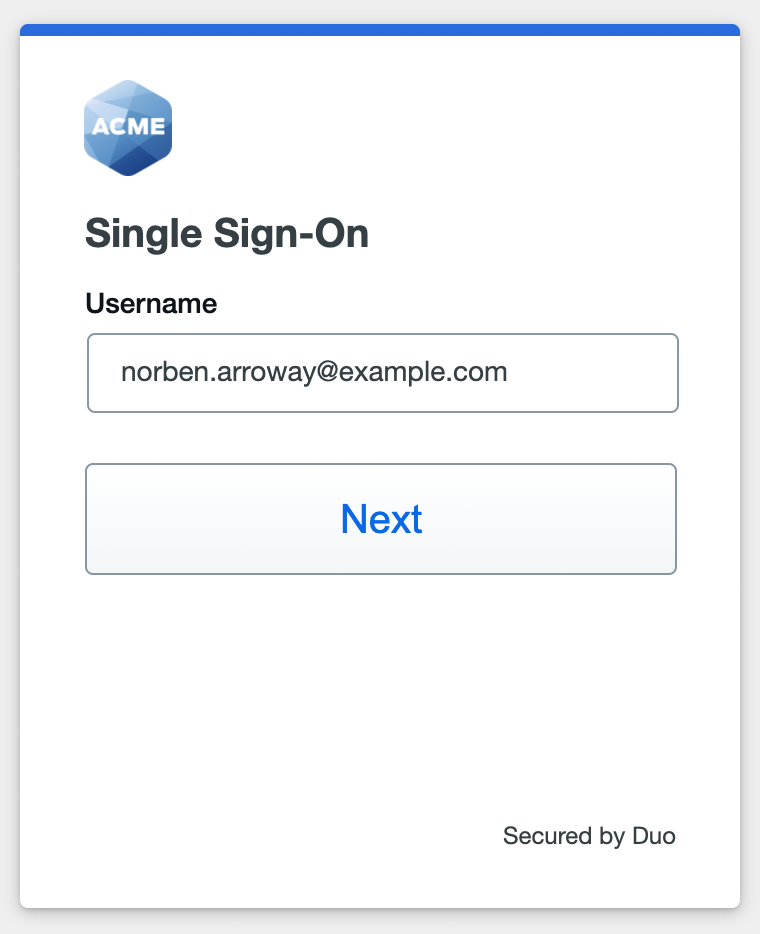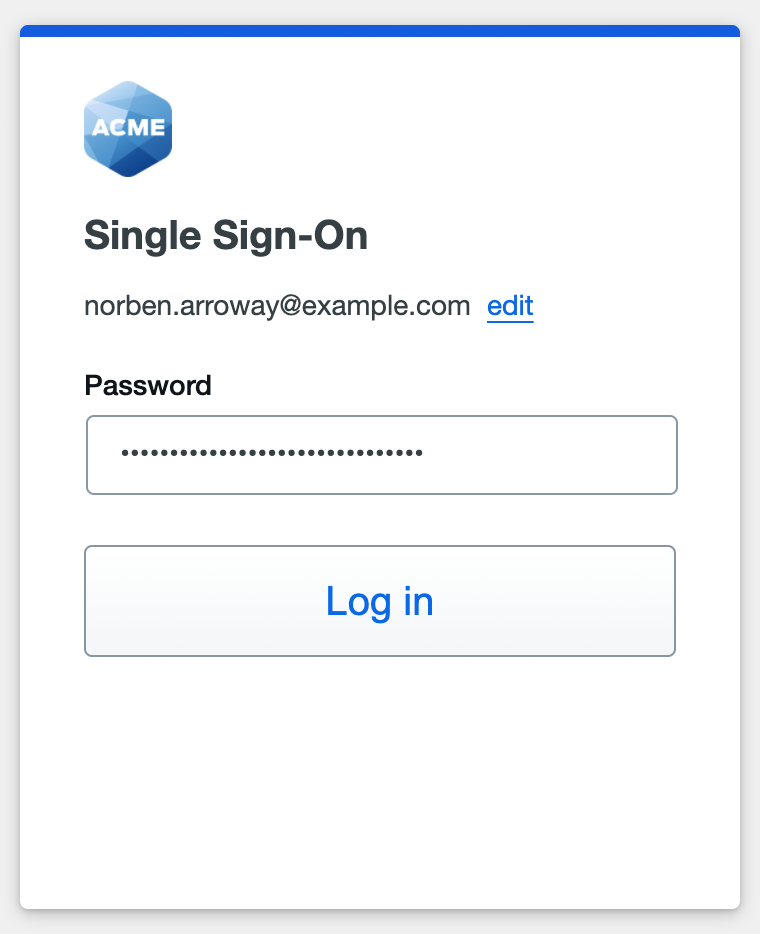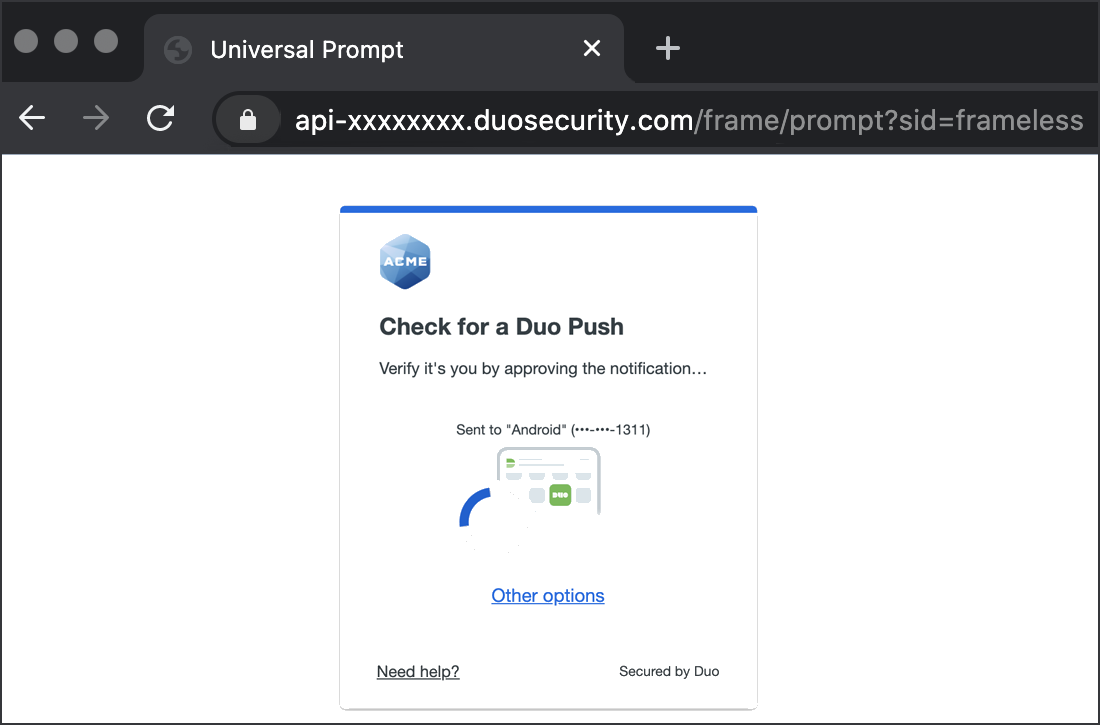Duo Single Sign-On for OpenText ALM Octane
Last updated:
Overview
As business applications move from on-premises to cloud hosted solutions, users experience password fatigue due to disparate logons for different applications. Single sign-on (SSO) technologies seek to unify identities across systems and reduce the number of different credentials a user has to remember or input to gain access to resources.
While SSO is convenient for users, it presents new security challenges. If a user's primary password is compromised, attackers may be able to gain access to multiple resources. In addition, as sensitive information makes its way to cloud-hosted services it is even more important to secure access by implementing two-factor authentication and zero-trust policies.
About Duo Single Sign-On
Duo Single Sign-On is our cloud-hosted SSO product which layers Duo's strong authentication and flexible policy engine on top of OpenText ALM Octane logins. Duo Single Sign-On acts as an identity provider (IdP), authenticating your users using existing on-premises Active Directory (AD) or another SSO IdP. Duo SSO prompts users for two-factor authentication and performs endpoint assessment and verification before permitting access to OpenText ALM Octane.
Duo Single Sign-On is available in Duo Premier, Duo Advantage, and Duo Essentials plans, which also include the ability to define policies that enforce unique controls for each individual SSO application. For example, you can require that Salesforce users complete two-factor authentication at every login, but only once every seven days when accessing OpenText ALM Octane. Duo checks the user, device, and network against an application's policy before allowing access to the application.
Configure Single Sign-On
Before configuring OpenText ALM Octane with Duo SSO using Security Assertion Markup Language (SAML) 2.0 authentication you'll first need to configure a working authentication source.
Once you have your SSO authentication source working, continue to the next step of creating the OpenText ALM Octane application in Duo.
Create the OpenText ALM Octane Application in Duo
-
Log in to the Duo Admin Panel and navigate to Applications → Application Catalog.
-
Locate the entry for OpenText ALM Octane with the "SSO" label in the catalog. Click the + Add button to start configuring OpenText ALM Octane. See Protecting Applications for more information about protecting applications with Duo and additional application options. You'll need the information on the OpenText ALM Octane page under Metadata later.
-
No active Duo users can log in to new applications until you grant access. Update the User access setting to grant access to this application to users in selected Duo groups, or to all users. Learn more about user access to applications. If you do not change this setting now, be sure to update it so that your test user has access before you test your setup.
This setting only applies to users who exist in Duo with "Active" status. This does not affect application access for existing users with "Bypass" status, existing users for whom the effective Authentication Policy for the application specifies "Bypass 2FA" or "Skip MFA", or users who do not exist in Duo when the effective New User Policy for the application allows access to users unknown to Duo without MFA. -
OpenText ALM Octane uses the Mail attribute, Username attribute, First name attribute, Last name attribute, and Display name attribute when authenticating. We've mapped these attributes to external authentication source attributes as follows:
Default Attribute Active Directory SAML IdP <Email Address> mail Email <Username> sAMAccountName Username <First Name> givenName FirstName <Last Name> sn LastName <Display Name> displayName DisplayName If you are using non-standard attributes for your authentication source, check the Custom attributes box and enter the names of the attributes you wish to use instead.
-
You can adjust additional settings for your new SAML application at this time — like changing the application's name from the default value, enabling self-service, or assigning a group policy.
-
Keep the Duo Admin Panel tab open. You will come back to it later.
Duo Universal Prompt
The Duo Universal Prompt provides a simplified and accessible Duo login experience for web-based applications, offering a redesigned visual interface with security and usability enhancements.
| Universal Prompt | Traditional Prompt |
 |
 |
The Duo OpenText ALM Octane application supports the Universal Prompt by default, so there's no additional action required on your part to start using the newest authentication experience.
Activate Universal Prompt
Activation of the Universal Prompt is a per-application change. Activating it for one application does not change the login experience for your other Duo applications. Universal Prompt is already activated for new OpenText ALM Octane applications at creation.
The "Universal Prompt" area of the application details page shows that this application's status is "Activation complete", with these activation control options:
- Show traditional prompt: Your users experience Duo's traditional prompt via redirect when logging in to this application.
- Show new Universal Prompt: (Default) Your users experience the Universal Prompt via redirect when logging in to this application.
The application's Universal Prompt status shows "Activation complete" both here and on the Universal Prompt Update Progress report.

For the time being, you may change this setting to Show traditional prompt to use the legacy experience. Keep in mind that support for the traditional Duo prompt ended for the majority of applications in March 2024. This option will be removed in the future.
Universal Update Progress
Click the See Update Progress link to view the Universal Prompt Update Progress report. This report shows the update availability and migration progress for all your Duo applications. You can also activate the new prompt experience for multiple supported applications from the report page instead of visiting the individual details pages for each application.
Prerequisites
You will need the following prerequisites before you can enable OpenText ALM Octane for SSO:
-
Access to the octane.conf configuration file. The path to the file is (Repository folder)\conf\octane.conf. Make sure you do not open the octane.conf.new configuration file.
-
Access to the sso.conf configuration file. The path to the file is (Repository folder)\conf\sso.conf.
-
Make sure you have HTTPS enabled on the server.
Enable OpenText ALM Octane for SSO
-
Open the octane.conf file in a text editor.
-
In the octane.conf file, search for "authentication".
-
On the authentication-type line, delete INTERNAL and type SSO between the quotation marks. Remove any leading # character in the sso.conf line if one is present. Your change should look like this:
authentication { authentication-type = "SSO" #include "ldap.conf" include "sso.conf" } -
In the octane.conf file, search for "key-store".
-
Copy the key-store file, password, and keystore-type lines. This is the key-store data for the HTTPS certificate you installed in the "Prerequisites" section earlier.
-
Save the octane.conf file.
-
Open the sso.conf file.
-
In the sso.conf file, search for "key-store".
-
Paste the key-store content you copied from the octane.conf file over the file, password, and keystore-type lines in the sso.conf file. The key-store lines in the octane.conf and sso.conf files should now be identical. Your change should look similar to this:
key-store { file = "/opt/octane/conf/keystore.jks" password = "ABC:DEf1GHJkmnpQ2rTvwX3Y4z==" keystore-type = "JKS" } -
In the sso.conf file, search for "key-pair".
-
Copy the alias of your key-pair certificate and paste in on the alias line, between the quotation marks.
-
Copy the password of your key-pair certificate and paste in on the password line, between the quotation marks. Your changes from this step and the one before should look similar to this:
key-pair { alias = "alm-server" password = "ABC:DEf1GHJkmnpQ2rTvwX3Y4z==" } -
In the sso.conf file, search for "oauth".
-
On the client-id line, enter a unique client ID value between the quotation marks.
-
On the client-secret line, enter a unique client secret value between the quotation marks. Your changes from this step and the one before should look similar to this:
oauth { # The oauth client id. Can be set to any value. client-id = "exampleid" # The oauth client secret. Can be set to any value. Should be complex and hard to guess. client-secret = "ABC:DEf1GHJkmnpQ2rTvwX3Y4z==" # Access token expiration timeout in seconds. Default value: 10800 (3 hours). authentication-timeout = 10800 } -
In the sso.conf file, search for "saml".
-
Return to the Duo Admin Panel. Under "Metadata", copy the Metadata URL and paste it on the metadata-url line between the quotation marks, in the sso.conf file.
Example: metadata-url = "https://sso-abc1def2.sso.duosecurity.com/saml2/sp/DIABC123678901234567/metadata"

-
Save the sso.conf file.
-
Restart the OpenText ALM Octane server for the changes to take effect.
-
After the server restarts, open a new private browsing window, such as Chrome Incognito or Edge InPrivate, and copy your host name and port number into the web address bar.
-
In the web address bar, type /osp/a/au/auth/saml2/metadata after your host name and port number.
Example: https://yourhostname:8181/osp/a/au/auth/saml2/metadata
-
Press Enter. The metadata file opens in the browser.
-
Save the metadata file locally to your computer. You can name the file anything you want.
-
Return to the Duo Admin Panel. Under "Service Provider", click Choose File and open the metadata file you downloaded earlier.
-
In the Duo Admin Panel, scroll down to the bottom of the page and click Save.
Learn more about OpenText ALM Octane SSO at the ALM Octane Help Center.
Using SSO
You can log on to OpenText ALM Octane by navigating to your OpenText ALM Octane SSO page e.g., https://yourhostname:8181. You will be automatically redirected to Duo Single Sign-On to begin authentication.
Active Directory Login
With Active Directory as the Duo SSO authentication source, enter the primary username (email address) on the Duo SSO login page and click or tap Next.

Enter the AD primary password and click or tap Log in to continue.

Enable Duo Passwordless to log in to Duo SSO backed by Active Directory authentication without entering a password in the future.
SAML Login
The SAML login experience depends on your Duo SSO routing rules configuration.
With another SAML identity provider as the only enabled Duo SSO authentication source and the default routing rule in place, Duo SSO immediately redirects the login attempt to that SAML IdP for primary authentication. Users do not see the Duo SSO primary login screen.
If you have multiple enabled SAML authentication sources or custom routing rules in place, then users enter their primary username (email address) on the Duo SSO login page and then will be redirected to the correct external SAML identity provider.
Duo Authentication
Successful verification of your primary credentials by Active Directory or a SAML IdP redirects back to Duo. Complete Duo two-factor authentication when prompted and then you'll return to OpenText ALM Octane to complete the login process.

* Universal Prompt experience shown.
You can also log into OpenText ALM Octane using Duo Central, our cloud-hosted portal which allows users to access all of their applications in one spot. Link to OpenText ALM Octane in Duo Central by adding it as an application tile. Once the tile has been added, log into Duo Central and click the tile for IdP-initiated authentication to OpenText ALM Octane.
Congratulations! Your OpenText ALM Octane users now authenticate using Duo Single Sign-On.
See the full user login experience, including expired password reset (available for Active Directory authentication sources) in the Duo End User Guide for SSO.
Grant Access to Users
If you did not already grant user access to the Duo users you want to use this application be sure to do that before inviting or requiring them to log in with Duo.
Enable Remembered Devices
To minimize additional Duo two-factor prompts when switching between OpenText ALM Octane and your other Duo Single Sign-On SAML applications, be sure to apply a shared "Remembered Devices" policy to your SAML applications.
Automated Provisioning
You may be able to create, manage, and delete users and groups in this application automatically from Duo using SCIM 2.0 provisioning. See Automated Provisioning to learn how.
Troubleshooting
Need some help? Try searching our Knowledge Base articles or Community discussions. For further assistance, contact Support.
